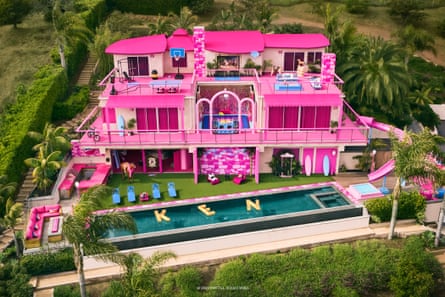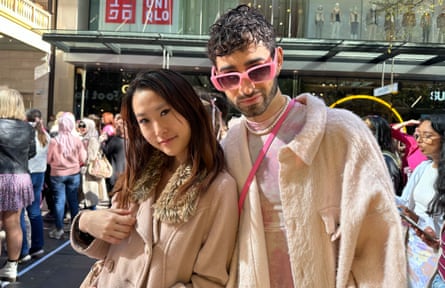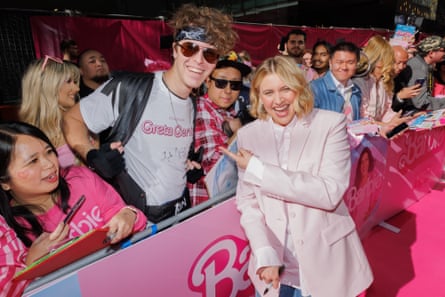Michaela Merkas wasn’t going to miss seeing Margot Robbie in person.
Since last year, she and friend Olivia Hooker have been obsessively following the increasingly lavish promotion for the upcoming Barbie movie – and now they’re crammed into a crowd in Sydney’s Pitt Street Mall, where the film’s stars Margot Robbie and America Ferrera are joining the first fan event of a global publicity tour.
Hooker has brought her own childhood Barbie doll and is clasping it tight. “I was so excited when I heard. I was like, ‘I have to go – whatever I have on that day, I don’t have any more, I’m going’,” she says.
“It’s been hyped on socials for a very long time,” Merkas adds. “The sneak peeks of the rollerblading scene – that is iconic.”
The Barbie movie campaign has been a masterclass in marketing, creating an instant modern icon from one that was six-decades-old. Since the emergence of those first photos in June 2022 – Robbie and Ryan Gosling decked out in fluoro pink and yellow, rollerblading the Venice Beach boardwalk in what Robbie would later describe as “the most humiliating moment of my life” – the anticipation has been fever pitch.
There’s a lifesize Barbie Dreamhouse in Malibu you can attempt to win a night at; an Architectural Digest tour of the plastic fantastic set; and brand tie-ups from suitcases and Xbox controllers to electric toothbrushes and makeup. And, yes, you can even buy those rollerblades for $US289 – plus another $US99 for the knee, elbow and wrist protectors.
If the film itself contributed to a global shortage of pink paint, its promo team didn’t help.

Barbie, which opens in Australia on 20 July and in the UK and US the following day, is expected be one of the biggest movies of the year. Directed and co-written by Lady Bird and Little Women’s Greta Gerwig, and starring Robbie, Gosling, Ferrera, Issa Rae and a teeming ensemble cast, the expectations are as stratospheric as Astronaut Barbie’s space station.
On Pitt Street Mall, the clamouring crowd is decked out in all shades of pink – magenta, fuchsia, cerise, rose, neon and the rest. There are months-old babies in pink beanies, older women with hot pink-striped scarves, and a person in a rainbow-coloured tulle mermaid skirt. The stars greet fans lined-up along the Mall, signing Barbie dolls in boxes and taking photos before ascending the stage for a Q&A; in a refreshing sartorial moment, Robbie takes a selfie with a man in a Slipknot hoodie.
Vincent Nardella wears a string of pearls, pink-rimmed sunglasses and a marbled salmon-pink top layered under his blush jacket.
“Barbie was part of my childhood but one which was hidden,” he says. “I went to my sister’s room and played with her Barbie. To see that in real-life with this movie, it means a lot. It’s important to celebrate everyone and every type of person.”


Gerwig’s Barbie movie, produced through Robbie’s production company LuckyChap Entertainment, has been at pains to emphasise its inclusivity. The cast includes Barbies and Kens from all backgrounds and body types, with trans actor Hari Nef as Doctor Barbie.
During a media event the day before at Sydney’s Bondi beach, Gerwig says the target audience for the film is anyone from eight to 108. “It’s a movie that I think can really cut across generations and genders. Everyone can find a pink, glittery existential dance party in their heart.”
Gerwig’s mother wasn’t a fan of Barbie – which only made her child-self more interested in the toy. “I had a lot of hand-me-down Barbies, so I got a lot of Barbies who were like Kate McKinnon’s Weird Barbie. They didn’t have shoes and their clothes were backwards.”
After Robbie brought her on to the project, Gerwig went to Mattel headquarters, where the business opened up their archives for her.
“They took me through everything from 1959 until now,” she says – a deep dive which compelled Gerwig to re-position what Barbie’s legacy means to fans today.
“If there were rules, I think we broke all of them. That was part of the fun, in a way. Like, ‘Tell me what your sacred cows are and I will do something naughty with them’.”

Gerwig wanted to tap into the full gamut of emotions surrounding the Barbie brand, and all the different feelings – positive, negative and neutral – it evokes.
“If you love Barbie, you’re going to love it, if you hate Barbie, you’re going to love it,” Robbie says. “But if you just like a good movie, you’re going to love it.”
In Sydney’s Pitt Street Mall, the fans are definitely primed to love it.
“I have such a deep connection with Barbie,” says Hooker, still holding her doll. “I played with her as a kid and [continued] throughout high school. I was a bit judged for that but Barbie is coming back around. And it’s validating for me.”

